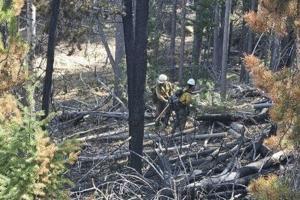OKLAHOMA CITY — Dr. Camisa Stewart was the emergency department director at a Guthrie hospital when the bomb tore through the Murrah Federal Building on April 19, 1995. She was at home in northwest Oklahoma City when she heard the explosion.
“It looked like the whole wall moved,” she said. Stewart hurried to the emergency room at what was then Baptist Medical Center to see how she could help and learned first responders were asking for physicians to come to the site. When a rescue team found 20-year-old Daina Bradley alive in the basement with her right leg pinned under concrete, Stewart was one of three doctors who were brought in to help.

Dr. Andy Sullivan, a pediatric orthopedic surgeon, had to amputate Bradley’s leg at the knee to free her. Dr.
David Tuggle, a pediatric surgeon, was also there. Stewart knew both men as mentors and teachers. The angle of the concrete lying on Bradley’s leg forced Sullivan to work in a “really tight” space, Stewart recalled.
The doctors could not establish an IV or administer anything to knock her out for fear of suppressing Bradley’s respiration, she said. The best they could do was give her a sedative “to take the edge off.” Bradley lost her leg, her mother and her two young children that day, but survived.
Over the next eight days Stewart volunteered at the site, doing whatever was needed. “What I saw were people that were tired – solemn but determined to honor those who lost their lives – defy the evil that had come to our city and state,” she said. “We were able to witness the worst of humankind, but we responded with the best of humankind.
” Stewart never saw Bradley again and rarely talked publicly about the experience over the years. “As physicians, we compartmentalize things. We see bad things in the emergency department,” she said.
“A little bit of me put what happened with the bombing in a little shoe box to the side ...
I didn’t deal with a lot of that.” Staff at the Oklahoma City National Memorial & Museum said many people who had never told their story came forward as the 30th anniversary approached. In the past 18 months, Stewart has told them her story for the archives, volunteered at the Memorial Marathon and met with Sullivan for the first time since the bombing.
“I feel like it’s been healing and a relief to make this reconnection,” Stewart said. In 2006, Stewart retired from emergency medicine when spinal stenosis made it difficult for her to lift, push and pull. She took a year off and took stock of her situation.
“In the emergency room, we took care of a lot of mental health issues,” she said. “The natural path to go was psychiatry.” Following three years of training and board certification, Stewart went to work for the Northcare community mental health agency for 12 years, retiring in 2022.
Working as a psychiatrist helped her realize how trauma from the bombing affected her, other individuals, their families and the whole community. The bombing that killed 168 people, including 19 children, and injured hundreds more three decades ago stands as one of the deadliest acts of domestic terrorism in U.S.
history. The 30th Anniversary Remembrance Ceremony will begin at 8:30 a.m.
Saturday at First Church at the corner of NW 5th and Robinson Avenue. Former President Bill Clinton is the keynote speaker for the ceremony, which will include 168 moments of silence, a reading of the names of those killed, and remarks from survivors, family members and community leaders. Following the ceremony, the Memorial Museum will be open free of charge courtesy of Cox Community Day.
.
Health

Doctor reflects on rescue 30 years after 1995 bombing

Dr. Camisa Stewart reflects on treating a bombing survivor and how the 1995 Oklahoma City attack shaped her life and career in medicine.The post Doctor reflects on rescue 30 years after 1995 bombing first appeared on The Journal Record.















